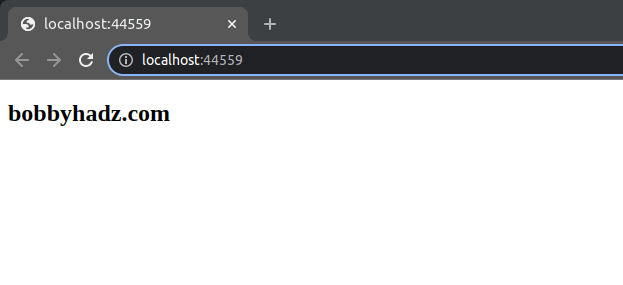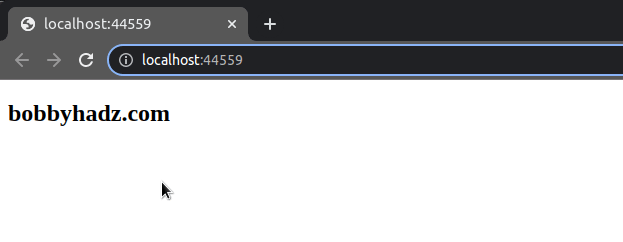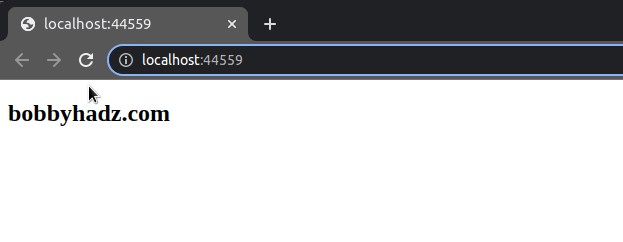How to auto-reload a Page every N seconds using JavaScript
Last updated: Mar 7, 2024
Reading time·4 min

# Table of Contents
- Auto-reload a Page every N seconds using setInterval in JavaScript
- Using the
http-equivdirective to auto-refresh the page every N seconds - Using the
setTimeout()function to auto-refresh the page every N seconds - Using the
window.onloadevent to auto-refresh a page every N seconds
# Auto-reload a Page every N seconds using setInterval in JavaScript
To auto-reload a page every N seconds in JavaScript:
- Use the
setInterval()method to run a function every 1000 milliseconds. - Declare a timer variable that gets incremented every second.
- Once the timer variable reaches the given number of seconds, call the
window.location.reload()method.
Here is the HTML for the example.
<!DOCTYPE html> <html lang="en"> <head> <meta charset="UTF-8" /> </head> <body> <h2>bobbyhadz.com</h2> <h2 id="refresh-timer"></h2> <script src="index.js"></script> </body> </html>
And here is the related JavaScript code.
const refreshTimer = document.getElementById('refresh-timer'); let timerInSeconds = 0; setInterval(() => { timerInSeconds += 1; refreshTimer.innerHTML = `Refreshing page in 3 sec: ${timerInSeconds} seconds`; if (timerInSeconds >= 3) { window.location.reload(); } }, 1000);

We used the document.getElementById()
method to select the refresh-timer element by its ID.
We could've also used the document.querySelector() method to achieve the same result.
const refreshTimer = document.querySelector('#refresh-timer');
We used the setInterval() method to repeatedly call a function every N milliseconds.
We called the function every 1000 milliseconds (1 second) to update the
innerHTML
property of the refresh-timer element.
const refreshTimer = document.getElementById('refresh-timer'); let timerInSeconds = 0; setInterval(() => { timerInSeconds += 1; refreshTimer.innerHTML = `Refreshing page in: ${timerInSeconds} seconds`; if (timerInSeconds >= 3) { window.location.reload(); } }, 1000);
Each time the callback function is invoked:
- We increment the timer by 1 second.
- We update the
innerHTMLproperty of the refresh timer element to display how many seconds remain until the page is refreshed.
The example refreshes the page every 3 seconds, however, you can adjust this depending on your use case.
The following code sample refreshes the page every 5 seconds.
const refreshTimer = document.getElementById('refresh-timer'); let timerInSeconds = 0; setInterval(() => { timerInSeconds += 1; refreshTimer.innerHTML = `Refreshing page in: ${timerInSeconds} seconds`; if (timerInSeconds >= 5) { window.location.reload(); } }, 1000);
Once the timer reaches the specified number of seconds, the page is auto-reloaded using the window.location.reload() method.
The location.reload() method reloads the current URL in the same way the
Refresh button does.

# Using the http-equiv directive to auto-refresh the page every N seconds
You can also use the http-equiv directive to auto-reload the page every N seconds.
The following example doesn't require you to use JavaScript.
<!DOCTYPE html> <html lang="en"> <head> <meta charset="UTF-8" /> <!-- 👇️ Auto-refresh every 3 seconds --> <meta http-equiv="refresh" content="3" /> </head> <body> <h2>bobbyhadz.com</h2> <h2 id="refresh-timer"></h2> </body> </html>

Adding the following meta tag to the head section of your HTML page
auto-refreshes the page every 3 seconds.
<meta http-equiv="refresh" content="3" />
When the http-equiv attribute is set to refresh, the browser is instructed
to reload the page after the specified content seconds.
The content attribute is set to 3, so the page gets reloaded after 3
seconds.
# Using the setTimeout() function to auto-refresh the page every N seconds
You can also use the setTimeout() function to auto-refresh the page every N
seconds.
Here is the HTML for the example.
<!DOCTYPE html> <html lang="en"> <head> <meta charset="UTF-8" /> </head> <body> <h2>bobbyhadz.com</h2> <script src="index.js"></script> </body> </html>
And here is the related JavaScript code.
setTimeout(() => { window.location.reload(); }, 3000);

The setTimeout() method sets a timer that executes a function after a specified delay.
Note that the delay is specified in milliseconds.
1000 milliseconds = 1 second, so using a value of 3000 milliseconds refreshes the page every 3 seconds.
# Using the window.onload event to auto-refresh a page every N seconds
You can also use the window.onload event to auto-refresh a page every N seconds.
Here is the HTML for the example.
<!DOCTYPE html> <html lang="en"> <head> <meta charset="UTF-8" /> </head> <body> <h2>bobbyhadz.com</h2> <h2 id="refresh-timer"></h2> <script src="index.js"></script> </body> </html>
And here is the related JavaScript code.
window.onload = function refreshEveryNSeconds() { const refreshTimer = document.getElementById('refresh-timer'); let timerInSeconds = 0; setInterval(() => { timerInSeconds += 1; refreshTimer.innerHTML = `Refreshing page in: ${timerInSeconds} seconds`; if (timerInSeconds >= 3) { window.location.reload(); } }, 1000); };

The load event is triggered when the whole page has loaded, including the
page's stylesheets, scripts, iframes and images.
Waiting for the load event might be necessary if you want to render the entire
page before you start the timer.
- We used the
setInterval()method to run some code every 1 second (1000 milliseconds). - Each time the callback function is run, we update the
innerHTMLattribute of the refresh timer element to display the time before the page is refreshed. - We also increment the timer by 1 second.
- Once the timer reaches 3 seconds, we use the
window.location.reload()method to refresh the page.
I've also written an article on how to refresh an image with a new one at the same URL using JS.
# Additional Resources
You can learn more about the related topics by checking out the following tutorials:
- Download Images using JavaScript (Local and from URL)
- How to fetch Data on Button click in React
- TypeError: Failed to fetch and CORS in JavaScript [Solved]
- fetch() returns empty Response Body in JavaScript [Solved]
- How to Use an Image as a Link in React.js
- Disable drag and drop on HTML elements using JavaScript
- Pass a Variable from one HTML page to Another in JavaScript

